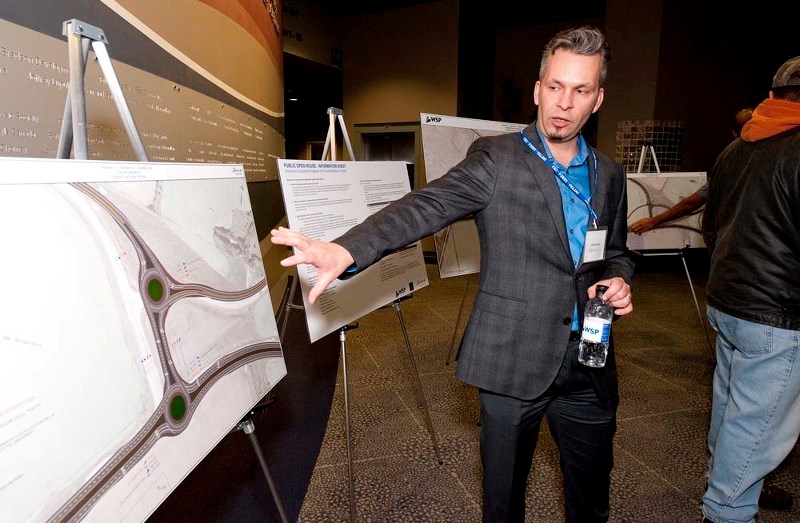County residents are criticizing what they say are the province's Band-Aid solutions for the daily traffic jams on Highway 37 leading to Fort Saskatchewan.
County residents got their first look at two proposed upgrades to the intersections of highways 37, 15 and 825 on Feb. 26 at an open house at the Dow Centennial Centre in Fort Saskatchewan.
Alberta Transportation held the event to get comments on its two proposed solutions for traffic jams at these intersections, which are within a few hundred metres of each other.
This region has been one of the county's top concerns for many years, said area councillor Ferd Caron. There are three highways that all meet within about half a block of each other, which has a serious impact on traffic going to and from the Sturgeon Industrial Park and Fort Saskatchewan, he said.
"For the residents that do live (there), it's been a real major headache," Caron said.
Dayna, who didn't want her last name used, said she and her husband drive through the intersections about six times a day on the way to Fort Saskatchewan and regularly run into major delays.
"By 4:30, if you're trying to leave the Fort, it can take you 20 to 25 minutes to get across the bridge (over the North Saskatchewan)," she said. "If you leave too late, you'll be stuck for 45 minutes."
Dayna, who lives near these intersections, said she's seen backups as long as 55 cars at these intersections, with impatient drivers driving in ditches to get around them.
Some drivers will switch to side roads like the one by her house, blasting by at up to 120 kilometres an hour (the speed limit is 80), she said.
"They're hitting cats. They're putting dogs at risk. I can't let my kids ride their bikes up and down the road because these cars are coming by too fast," she said.
And these intersections are just getting busier and busier as the industrial heartland develops, Caron said.
"We need to improve it for safety's sake."
Roundabouts or lights?
The province asked WSP Canada Inc. to draw up some solutions, said project manager Doug Lunde.
About 20,700 cars currently pass through the two intersections each day, with about 74 per cent of them passing through the intersection of highways 37 and 15. Traffic at these intersections is projected to jump to about 35,050 cars a day in 20 years.
WSP came up with two possible solutions, Lunde said.
The first is to put roundabouts at both intersections. This would cost about $17 million and have the best traffic flow, as there would be no stop-and-go traffic. It would also be able to handle the most cars.
But it could also prove confusing for drivers, especially since the Hwy. 15/37 intersection would (in 16 years) have to become a three-lane roundabout to accommodate traffic volumes, making it the only one of its kind in the province. Two-lane roundabouts are also rarities in rural Alberta.
While roundabouts are generally safer than intersections, Lunde's team found that the novelty of these new ones could confuse residents, making them less safe.
A three-lane roundabout works the same as a two-lane, Lunde said – take the first exit if you're in the outer lane, and any other exit in the two inner lanes.
"Driver education is very important so people know how to use them," he said.
Caron said this solution is workable, but worried that many people wouldn't know how to use the roundabouts.
"You can make some real big errors with semis."
Dayna questioned if the roundabouts would actually keep flowing given the amount of cars in them.
"Option one makes absolutely no sense," she said.
Option two is to signalize both intersections for about $15 million, Lunde said. This would be simpler to use and easier to convert into an interchange, but would have less capacity and more collision risk than a roundabout.
Caron gave this option a reluctant thumbs-up.
"It slows the traffic down to make it safer," he said, and could lead into a future interchange.
Band-Aid?
County potato farmer Wayne Groot questioned why it took the province so long to address these intersections, noting that the region has known about these issues for at least a decade.
"We're 10 years late," he said. "We're getting all this industry, but the infrastructure is not keeping up with it. Us citizens are stuck fighting traffic all the time."
Alberta Transportation has been occupied with other pressures in the province up until now, said Michal Pylko, construction manager for that department. The department also been studying this intersection for about two years.
This project is not on the province's three-year capital plan, meaning it won't happen anytime soon. That could change with this Thursday's provincial budget, however, Pylko noted.
Caron, Dayna and Groot agreed that roundabouts and traffic lights are temporary solutions for these intersections. Caron and Groot called for an interchange. Dayna suggested a new bridge over the North Saskatchewan.
An interchange is the ultimate solution, but that's years away, Lunde said.
"This is intended to be an interim solution."
Have a question?
Contact project manager Doug Lunde at [email protected].




